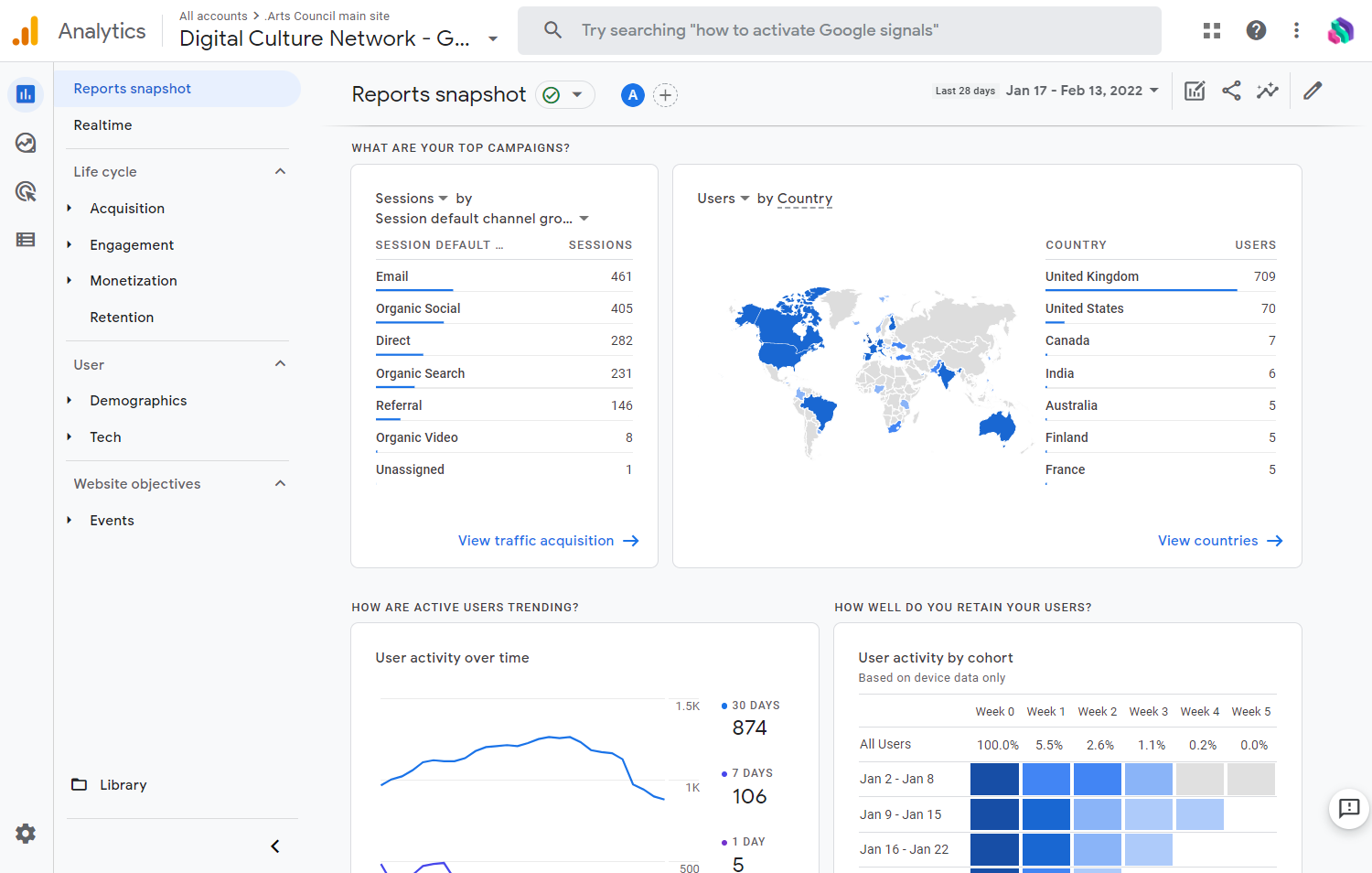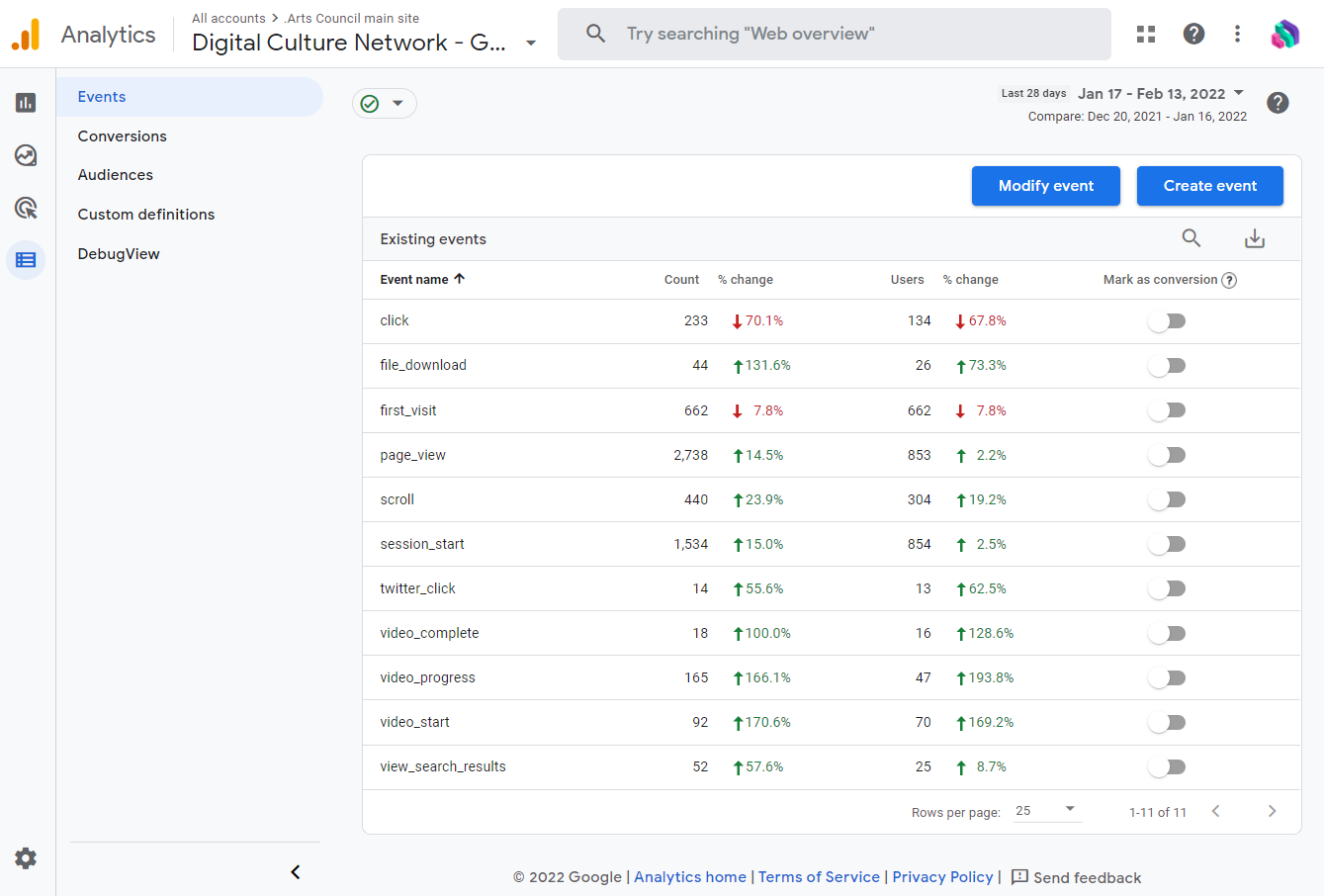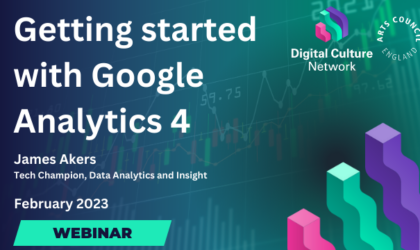
Beginner Read Webinars Data Analytics and Insight
A webinar to help arts and culture organisations plan for the changes to Google Analytics coming in 2023.
In this article
If you want to understand how users interact with your website, you can use a web analytics tool to capture data and explore reports. A popular free tool, used on an estimated 86% of websites, is Google Analytics.
In 2021, Google released a brand new version, completely rewritten from the ground up, called Google Analytics 4. In this article, we will explore the new version, its pros and cons, and what arts and culture organisations could do with it right now.
Google Analytics 4 (GA4) was launched to address the changing technology and online privacy landscape. The previous version, Google Universal Analytics (UA), is based on technology that is fast becoming outdated. They have also announced they will be switching off Universal Analytics on 1 July 2023.
The biggest difference between Universal Analytics and GA4 is the way data is collected and recorded (the measurement model). Universal Analytics measurement is based on sessions and pageviews, whereas GA4 uses a model based on events and parameters. This shift opens up the possibilities of what and how data can be collected, and how it’s customised to each unique website or application.
New users logging into GA4 are sometimes intimidated by the new layout. The familiar Universal Analytics interface is gone, along with its standard reports and metrics.

Another stumbling block for new users is you need to explicitly tell GA4 what you want to track and report on. The flexibility of the new event and parameter model means there are limited standard reports and metrics, it is up to you to define what you want to know.
Additionally, many of the reports and metrics are only generated once you start tracking events and sending data to GA4, they do not appear at all and cannot be found until you do.
In Universal Analytics, events are used to supplement pageviews. For example, if you wanted to track an action that takes place on a webpage, such as a form submission, this could be passed to analytics as an event.
In GA4, events are no longer tied to pageviews, everything can be an event and include much more data as additional parameters.

There is a new naming convention for events and Google will automatically collect some with any GA4 installation. There are also Enhanced measurement events that you can turn on, these include Page view, Scroll, Outbound clicks, Site search, Video engagement, and File downloads.
For anything else you would like to track you can try matching them to Google’s Recommended events to unlock additional reporting capabilities. This is the most difficult part when getting to grips with GA4. It requires an advanced level of custom configuration and you may need the help of a developer for some of the complex tracking elements.
GA4 introduces new functionality and features which aim to give you further insight into your users and prepare for a cookie-less future. Here are a few of the highlights:
GA4 is a very new platform with functionality being added all the time. With that in mind there are a couple of things to consider:
Even if you don’t intend to use GA4 just yet, I recommend you install it alongside your current analytics platform and turn on Enhanced measurement. Your account will then begin collecting data about your users and its machine-learning capabilities will help build audiences and predict actions for the future.
For a step-by-step guide to set this up, watch my webinar recording and access the additional resources.
Google announced they will be switching off Google Universal Analytics on 1 July 2023. Accounts will no longer collect any new data and only historical data will be available for at least six months. After July 2023 you will need to switch to GA4 or an alternative analytics provider.
It is important to export any historical data you wish to keep. The depth of information you wish to look back on in the future will determine how much you may need to export, and at what level.
This article from After Digital explains how to archive your Universal Analytics data and the different options available.
In this introductory Google Analytics 4 article, we’ve covered key functionality and recommended next steps. If you’re keen to learn more or need help with any of the steps, check out the links below.
The Digital Culture Network is here to support you and your organisation. Our Tech Champions can provide free 1-2-1 support to all arts and cultural organisations who are in receipt of, or eligible for, Arts Council England funding. If you need help or would like to chat with us about any of the advice we have covered above, please get in touch. Sign up for our newsletter below and follow us on Twitter @ace_dcn for the latest updates.
Related content by topic
Making the Most Out of Your Data Google Analytics Google Analytics 4 BigQuery
Beginner Read Webinars Data Analytics and Insight
A webinar to help arts and culture organisations plan for the changes to Google Analytics coming in 2023.
Beginner Read Data Analytics and Insight
In this article, we explain the steps to set up and configure the digital analytics platform Google Analytics 4 with Spektrix to enhance your reporting with eCommerce data.
Beginner Read Webinars Data Analytics and Insight
A webinar for creative and culture organisations who wish to create, configure and install Google Analytics 4.
Beginner Read Data Analytics and Insight
What can you learn from the data your organisation holds? Read on to understand how to get started on analysing your data and using it to effect positive change.
Beginner Read Data Analytics and Insight
Explore our top tips for embracing Data Analytics & Insight in your organisation.
Beginner Read Data Analytics and Insight
Do you have a good understanding of your organisation's data analytics tools? Our checklist will help you assess and improve your audience insight.




